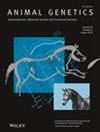Apeksha, Abhishek Mahendra Todkari, Ashok Chaudhary, Mir Mehroz Hassan, Diksha Upreti, Shri Ram Saini, Sheikh Firdous Ahmad, Ashwni Kumar Pandey
下载PDF
{"title":"Decoding DNA methylation in Staphylococcus aureus mastitis: Implications for immune regulation and disease resistance","authors":"Apeksha, Abhishek Mahendra Todkari, Ashok Chaudhary, Mir Mehroz Hassan, Diksha Upreti, Shri Ram Saini, Sheikh Firdous Ahmad, Ashwni Kumar Pandey","doi":"10.1111/age.70044","DOIUrl":null,"url":null,"abstract":"<p>Mastitis is a major health and economic threat to the dairy industry, causing massive losses every year worldwide. <i>Staphylococcus aureus</i> is the chief pathogen, responsible for most of the subclinical as well as a considerable portion of the clinical cases. Conventional control strategies, including antibiotic treatment and genetic selection for resistance, have shown limited success due to antimicrobial resistance and low heritability of mastitis resilience traits. This calls for the exploration of novel approaches such as epigenetics, that offers insights into host–pathogen interactions beyond the genetic variations. This review focuses on DNA methylation changes in the mammary gland that occur during <i>S. aureus</i> mastitis. Recent research has identified immune suppression and pathogen persistence in relation with DNA methylation during the disease. The microbe has been reported to alter the methylation status of regulatory regions for many immune genes such as <i>CXCR1</i>, <i>TNF-α</i>, <i>IL6R</i>, <i>IL10</i>, and <i>C3</i>, resulting in dysregulation of immune responses in the host, thereby facilitating pathogen persistence and chronic infection. Along with its own virulence factors, differential DNA methylation status of such genes during infection helps the pathogen to escape host defence, and decreases the intensity of inflammation. Thus, understanding these mechanisms can open new avenues in the field of disease diagnosis, animal selection, and immunotherapy among others. Such an integrative approach offers a revolution in mastitis control strategies, ensuring better health and productivity in dairy animals. © 2025 Stichting International Foundation for Animal Genetics.</p>","PeriodicalId":7905,"journal":{"name":"Animal genetics","volume":"56 5","pages":""},"PeriodicalIF":2.1000,"publicationDate":"2025-09-25","publicationTypes":"Journal Article","fieldsOfStudy":null,"isOpenAccess":false,"openAccessPdf":"https://onlinelibrary.wiley.com/doi/epdf/10.1111/age.70044","citationCount":"0","resultStr":null,"platform":"Semanticscholar","paperid":null,"PeriodicalName":"Animal genetics","FirstCategoryId":"99","ListUrlMain":"https://onlinelibrary.wiley.com/doi/10.1111/age.70044","RegionNum":3,"RegionCategory":"生物学","ArticlePicture":[],"TitleCN":null,"AbstractTextCN":null,"PMCID":null,"EPubDate":"","PubModel":"","JCR":"Q2","JCRName":"AGRICULTURE, DAIRY & ANIMAL SCIENCE","Score":null,"Total":0}
引用次数: 0
引用
批量引用
Abstract
Mastitis is a major health and economic threat to the dairy industry, causing massive losses every year worldwide. Staphylococcus aureus is the chief pathogen, responsible for most of the subclinical as well as a considerable portion of the clinical cases. Conventional control strategies, including antibiotic treatment and genetic selection for resistance, have shown limited success due to antimicrobial resistance and low heritability of mastitis resilience traits. This calls for the exploration of novel approaches such as epigenetics, that offers insights into host–pathogen interactions beyond the genetic variations. This review focuses on DNA methylation changes in the mammary gland that occur during S. aureus mastitis. Recent research has identified immune suppression and pathogen persistence in relation with DNA methylation during the disease. The microbe has been reported to alter the methylation status of regulatory regions for many immune genes such as CXCR1 , TNF-α , IL6R , IL10 , and C3 , resulting in dysregulation of immune responses in the host, thereby facilitating pathogen persistence and chronic infection. Along with its own virulence factors, differential DNA methylation status of such genes during infection helps the pathogen to escape host defence, and decreases the intensity of inflammation. Thus, understanding these mechanisms can open new avenues in the field of disease diagnosis, animal selection, and immunotherapy among others. Such an integrative approach offers a revolution in mastitis control strategies, ensuring better health and productivity in dairy animals. © 2025 Stichting International Foundation for Animal Genetics.
在金黄色葡萄球菌乳腺炎中解码DNA甲基化:对免疫调节和疾病抵抗的影响
乳腺炎是对乳制品行业的主要健康和经济威胁,每年在世界范围内造成巨大损失。金黄色葡萄球菌是主要病原菌,大多数亚临床病例和相当一部分临床病例都是由金黄色葡萄球菌引起的。传统的控制策略,包括抗生素治疗和耐药性的遗传选择,由于抗菌素耐药性和乳腺炎恢复力性状的低遗传力,已经显示出有限的成功。这需要探索新的方法,如表观遗传学,它提供了超越遗传变异的宿主-病原体相互作用的见解。本文综述了金黄色葡萄球菌乳腺炎期间发生的乳腺DNA甲基化变化。最近的研究已经确定了疾病期间与DNA甲基化有关的免疫抑制和病原体持久性。据报道,这种微生物可以改变许多免疫基因(如CXCR1、TNF-α、IL6R、IL10和C3)调控区域的甲基化状态,导致宿主免疫反应失调,从而促进病原体的持续存在和慢性感染。在感染过程中,这些基因的不同DNA甲基化状态,连同其自身的毒力因素,有助于病原体逃避宿主的防御,并降低炎症的强度。因此,了解这些机制可以在疾病诊断、动物选择和免疫治疗等领域开辟新的途径。这种综合方法为乳腺炎控制策略提供了一场革命,确保奶牛更好的健康和生产力。©2025 Stichting国际动物遗传学基金会。
本文章由计算机程序翻译,如有差异,请以英文原文为准。


 求助内容:
求助内容: 应助结果提醒方式:
应助结果提醒方式:


